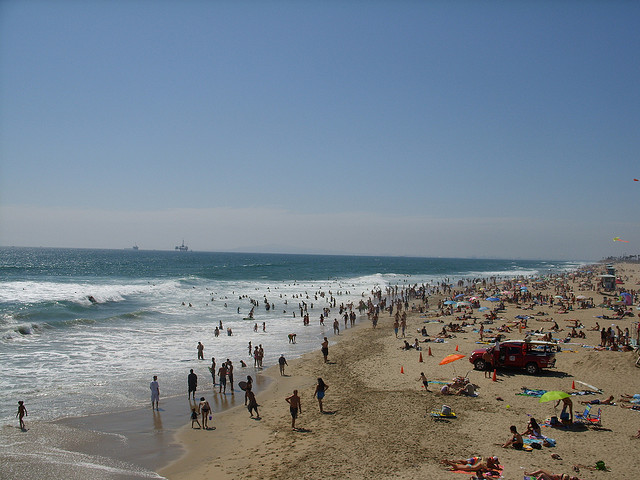8 December 2011
Nutrients and bacteria surf the internal waves of Huntington Beach
Posted by kramsayer

Waves make Huntington Beach a popular attraction for surfers and sunbathers, but internal waves below the oceans surface appear to push undesirable sewage and nutrients close to shore. (Credit: Ben Becker, Flickr creative commons)
With a nickname like “Surf City,” waves clearly play an important role at Huntington Beach in Orange County, Calif. Surfers ride the breaking crests that roll in to shore, and swimmers splash in the foamy white spray. But these aren’t the ocean’s only waves – others travel below the surface, invisible to a tourist’s camera lens.
Such underwater, or internal, waves may push sewage and nutrients towards the beach, creating an icky environment for beachgoers.
Simon Wong, a graduate student at Stanford University, in Palo Alto, Calif., presented a poster Tuesday morning at the American Geophysical Union’s Fall Meeting that connected internal waves and water quality in the surf zone.
Internal waves occur in places where water layers of different densities sit one on top of the other, unmixed. Imagine a bottle of salad dressing that has separated into a layer of oil floating on a layer of water. If you shake the bottle slightly, you’ll see a rippling wave at the surface of the oil, and also a wave undulating where the two layers touch – your very own internal wave!
In the ocean, these layers of different densities can occur because of salinity (fresh water floats on salty water) or temperature (warmer water floats on colder water). Forces like the pull of the tides can create internal waves where two layers meet.
Because of the potential implications for human and environmental health, Wong and his colleagues were interested to see if such internal waves could transport sewage and nutrients close to shore.
During the summers of 2005 and 2006, they waded into the surf zone at Huntington Beach and collected water samples that they analyzed for certain bacteria. These bacteria, such as E. coli, are not necessarily harmful themselves, but are linked to increased likelihood of health risks and indicate the presence of fecal matter. The scientists also measured levels of nutrients like phosphate, silicate, and nitrogen, which can trigger phytoplankton blooms. Such algal blooms can secrete toxins or deplete oxygen when they decompose.
The researchers used three offshore moorings at depths of 10-20 meters (33-66 feet) to record temperature and currents that helped characterize the movement of internal waves near the beach. They found that the internal waves were highly variable, but tended to roll in to shore once or twice a day.
The team observed that more intense internal waves were correlated with higher concentrations of phosphate and silicate, but not nitrogen. Wong says one possible reason for this is that internal waves may indeed push nitrogen onshore, but phytoplankton quickly gobble it up the surf zone.
The scientists also observed a positive, significant correlation with all three fecal indicator bacteria they measured in 2006, but not 2005. Wong said the overall intensity of the internal waves was lower in 2005, which might explain the discrepancy.
While the correlation does not prove that internal waves are the sole cause of nutrient and bacteria concentration spikes, Wong said the results could have implications for the sewage outfall that runs offshore from the beach.
“They designed this outfall several decades ago, and according to the design, the plume should not be (washed up) to the shore,” Wong said. “However, if internal waves (transport) the sewage plume onshore, they may have to increase their water treatment.”
Water quality is a major public health concern in the highly popular, economically valuable beaches of Southern California.
“Of course, they can’t change the environment,” Wong said, “but they can change their practices.”
-Erin Loury is a science communication graduate student at UC Santa Cruz


 GeoSpace is a blog on Earth and space science, managed by AGU’s Public Information staff. The blog features posts by AGU writers and guest contributors on all sorts of relevant science topics, but with a focus on new research and geo and space sciences-related stories that are currently in the news.
GeoSpace is a blog on Earth and space science, managed by AGU’s Public Information staff. The blog features posts by AGU writers and guest contributors on all sorts of relevant science topics, but with a focus on new research and geo and space sciences-related stories that are currently in the news.